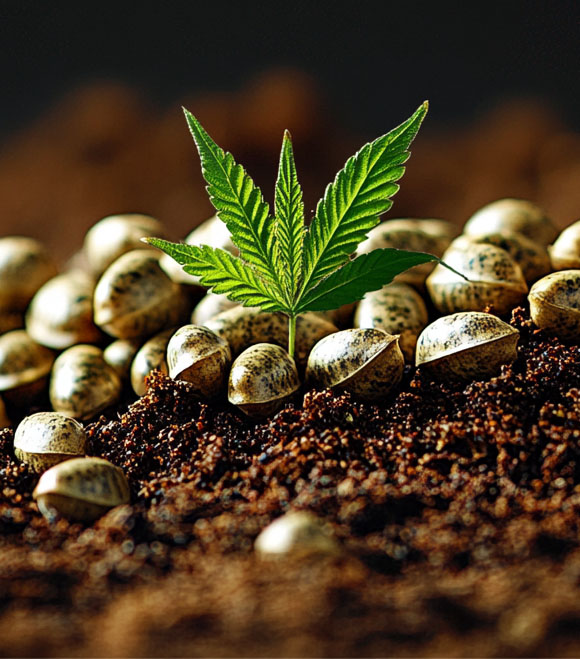Guide to Planting and Growing CBG Seeds
The Guide to Planting and Growing CBG Seeds provides a high level overview for cultivating CBG-rich hemp. It begins with foundational knowledge about CBG, a cannabinoid prized for its therapeutic potential and federally legal low THC levels (<0.3%). Key steps include selecting feminized, high-quality seeds from reputable sources, preparing nutrient-rich loamy soil with a balanced pH, and planting in late spring with proper spacing and depth.
Optimal care involves regular watering, efficient drip irrigation, and targeted fertilization using nitrogen during growth and phosphorus and potassium during flowering. Pest and disease management strategies emphasize natural remedies and good planting practices. Maintenance tips include ensuring adequate light, pruning for airflow, and monitoring plant health. Harvesting is timed for peak CBG levels, followed by drying and curing to enhance potency and flavor. This guide equips growers with the knowledge to produce high-quality CBG hemp efficiently and sustainably.


1. Understanding CBG and Hemp Basics
- What is CBG? CBG is a cannabinoid found in hemp plants, often referred to as the “mother of all cannabinoids” because it’s a precursor to other cannabinoids like CBD and THC.
- Why Choose CBG Hemp? CBG hemp is valued for its therapeutic potential and low THC levels (<0.3%), making it federally legal in the U.S.
2. Selecting CBG Seeds
- Feminized Seeds: Opt for feminized seeds to ensure the sowing of more than 95% female plants.
- High-Quality Strains: Research strains known to be stable have high CBG content and low THC levels.
- Source: Purchase seeds from reputable suppliers to ensure quality and compliance like CBGSeedSource.com
3. Preparing the Soil
- Ideal Soil Type: Hemp thrives in well-drained, loamy soil with a pH of 6.0–7.5.
- Testing: Conduct soil tests to check nutrient levels, pH, and contamination.
- Amendments: Add organic matter like compost or manure to enrich the soil.
4. Planting the Seeds
- Timing: Plant seeds in late spring after the last frost when soil temperatures reach 50–60°F (10–16°C).
- Spacing: Maintain a spacing of 4–5 feet between plants to allow proper airflow and sunlight penetration.
- Depth: Sow seeds about ½–¾ inch deep in the soil.
5. Watering and Irrigation
- Frequency: Water regularly, especially during the seedling stage, but avoid overwatering.
- Drip Irrigation: Use drip irrigation systems for efficient water use and to prevent waterlogging.
6. Fertilization
- Nutrients Needed:
- Nitrogen (N) during the vegetative stage.
- Phosphorus (P) and Potassium (K) during flowering.
- Organic Options: Use organic fertilizers like fish emulsion, bone meal, or compost tea for sustainable farming.
7. Pest and Disease Management
- Common Pests: Aphids, spider mites, and caterpillars.
- Natural Remedies: Introduce beneficial insects like ladybugs or use neem oil.
- Diseases: Watch for root rot and powdery mildew. Use proper spacing and avoid overwatering to mitigate these issues.
8. Monitoring and Maintenance
- Light Needs: Hemp plants require 12–16 hours of light daily during the vegetative stage.
- Pruning: Remove lower leaves and branches to improve airflow and focus energy on flower production.
9. Harvesting
- When to Harvest: Harvest when trichomes are mostly cloudy, which indicates peak CBG levels.
- Method: Use hand trimmers to cut plants and hang them upside down in a dark, well-ventilated area for drying.
10. Post-Harvest Processing
- Drying: Dry flowers slowly at 60°F–70°F with 50–60% humidity.
- Curing: Cure buds in airtight containers, burping them daily for the first two weeks to improve potency and flavor.
Additional Notes
- Hemp Regulations: Always comply with local laws regarding THC levels and hemp cultivation permits.
- Outdoor vs. Indoor:
- Outdoor: Suitable for large-scale farming; depends on natural sunlight and weather.
- Indoor: Allows better control over growing conditions but can be costlier.

